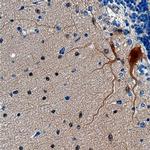Search Thermo Fisher Scientific
FIGURE: 1 / 1
SHANK2 Antibody (MA5-24331) in IHC (P)

Product Details
MA5-24331
Species Reactivity
Host/Isotype
Class
Type
Clone
Immunogen
Conjugate
Form
Concentration
Purification
Storage buffer
Contains
Storage conditions
Shipping conditions
RRID
Product Specific Information
Reconstitute in sterile PBS to a final concentration of 0.5 mg/mL.
Target Information
This gene encodes a protein that is a member of the Shank family of synaptic proteins that may function as molecular scaffolds in the postsynaptic density of excitatory synapses. Shank proteins contain multiple domains for protein-protein interaction, including ankyrin repeats, and an SH3 domain. This particular family member contains a PDZ domain, a consensus sequence for cortactin SH3 domain-binding peptides and a sterile alpha motif. The alternative splicing demonstrated in Shank genes has been suggested as a mechanism for regulating the molecular structure of Shank and the spectrum of Shank-interacting proteins in the postsynaptic densities of the adult and developing brain. Alterations in the encoded protein may be associated with susceptibility to autism spectrum disorder. Alternative splicing results in multiple transcript variants.
For Research Use Only. Not for use in diagnostic procedures. Not for resale without express authorization.
References (0)
Bioinformatics
Protein Aliases: cortactin SH3 domain-binding protein; Cortactin-binding protein 1; CortBP1; CORTBP1CTTNBP1; GKAP/SAPAP interacting protein; proline-rich synapse associated protein 1; Proline-rich synapse-associated protein 1; SH3 and multiple ankyrin repeat domains protein 2; Shank2
Gene Aliases: AUTS17; CORTBP1; CTTNBP1; KIAA1022; PROSAP1; SHANK; SHANK2; SPANK-3
UniProt ID: (Human) Q9UPX8
Entrez Gene ID: (Human) 22941

Performance Guarantee
If an Invitrogen™ antibody doesn't perform as described on our website or datasheet,we'll replace the product at no cost to you, or provide you with a credit for a future purchase.*
Learn more
We're here to help
Get expert recommendations for common problems or connect directly with an on staff expert for technical assistance related to applications, equipment and general product use.
Contact tech support
